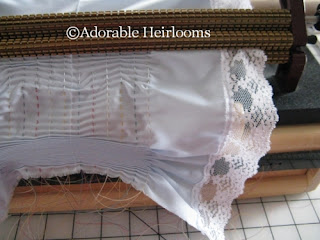Mystery Smock
Series II
"Up and Down"
I have been doing Mystery Smocks on my Facebook page for several years now and they have been extremely successful. They're so popular in fact, that recently a national smocking organization has started doing Mystery Smocks, but for members only. Mine have always been free to whomever would like to follow along, no membership needed, so I thought "Why not see how well they go over on the blog?"
If you've never participated in a Mystery Smock Along before, you're in for a real treat! It's fun, it's exciting and it's a mystery. Here are some things you should know before you decide to take part:
How to Pleat Fabric
How to locate the Center Valley or the Center Pleat
How to Smock a Cable, Trellis, Outline, Stem and combinations thereof
How to follow directions without having a photo of the finished product!
How to work a bullion rose OR a bullion daisy
How to work a lazy daisy
How to add beads or buttons and surface embroidery to smocking for embellishment
Once the plate is finished, you will have a finished insert to use how you see fit!
Instructions
Tie off only one end. That being said, if you're going to use this insert in a dress, you may want to block to size, so you would need to tie off both ends. I didn't and it's my habit not to.
Also, do not knot the smocking threads at the end of a row. Leave the tail, too. Many times I've noticed an error in row 1 only when I started to smock row 2. This is definitely a life and time saver. I used 3 strands of DMC Floss and DMC Perle Coton #8.
You will need a #20 tapestry needle, a #5 milliner needle and a #7 darner needle for smocking
Pick 3 hues of the same color and label them 1a [this should be lightest tone], 1b [this should be a medium tone, and 1c [this should be the deepest tone] These colors will be the center of the design and the focal point of the insert.
Pick 2 contrast, but not conflicting colors 2a [medium tone] and 2b [deep tone]. These colors will help to focus the eye on the center of design.
Pick 3 more hues of another color as your surface embroidery colors to work flowers and then a shade of green to work the leaves. These 3 colors are 3a [the lightest color], 3b [a medium color], and 3c [ the deepest color].
First Clue - Single cable, 4-Step-trellis motif. Use a #7 darner needle and 3 strands of floss.
Row 7
Use color 1b [medium tone]. Begin with a Down Cable over the Center Valley [CV]. Work a 4-Step trellis Up to Row 6. Work an Up Cable. Work a 4-Step trellis Down to Row 7. Work a Down Cable. Repeat across the Row. Do not knot off. Turn work upside down and work in same manner across to the opposite side.
Use color 1b [medium tone]. Begin with a Down Cable over the Center Valley [CV]. Work a 4-Step trellis Up to Row 6. Work an Up Cable. Work a 4-Step trellis Down to Row 7. Work a Down Cable. Repeat across the Row. Do not knot off. Turn work upside down and work in same manner across to the opposite side.










